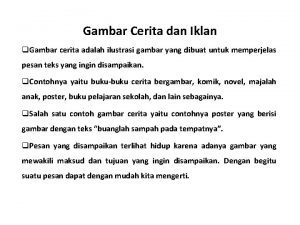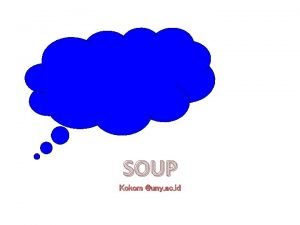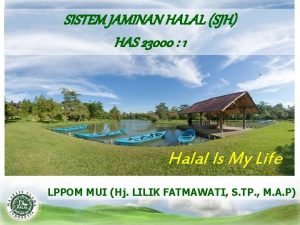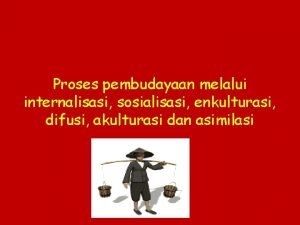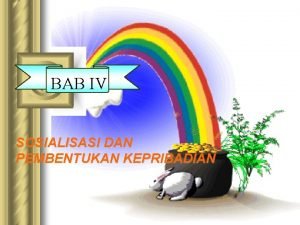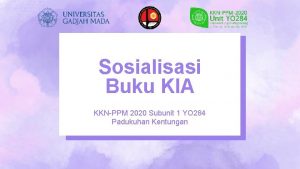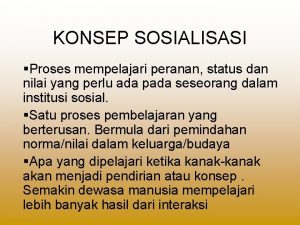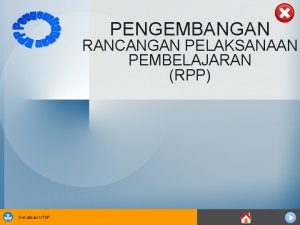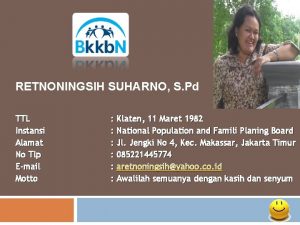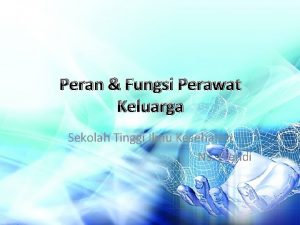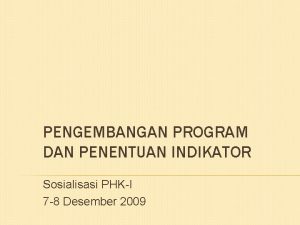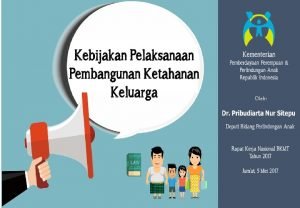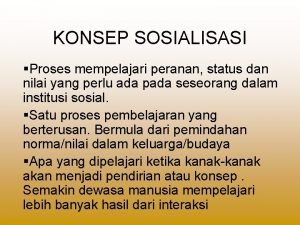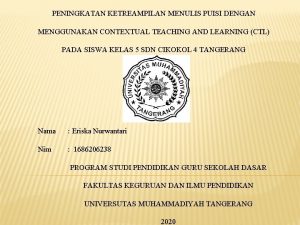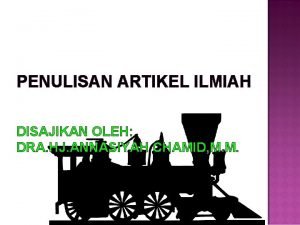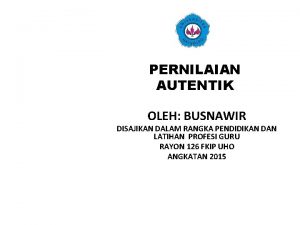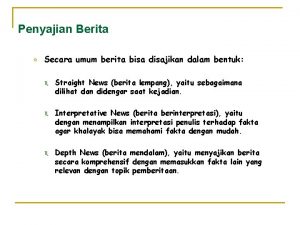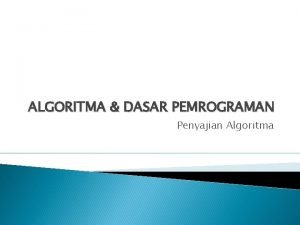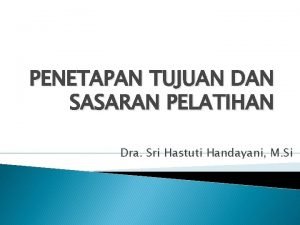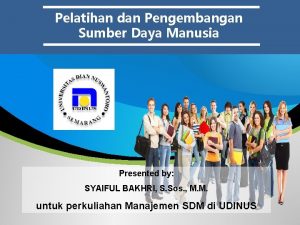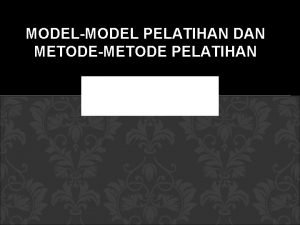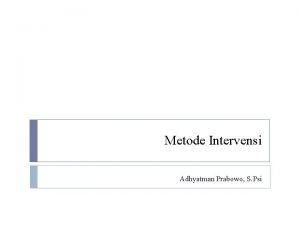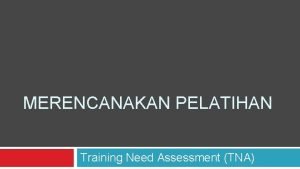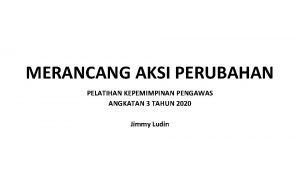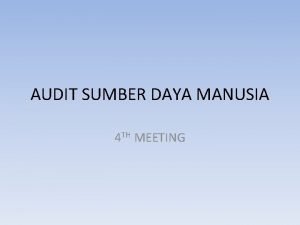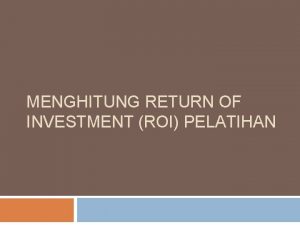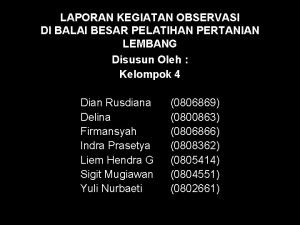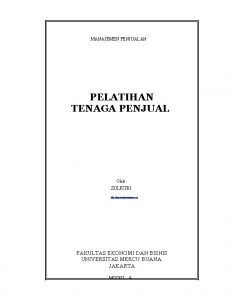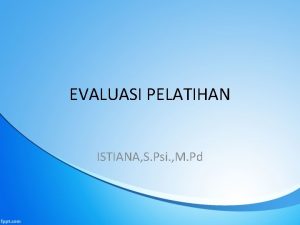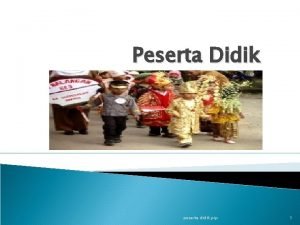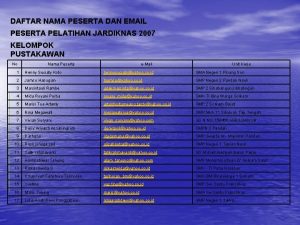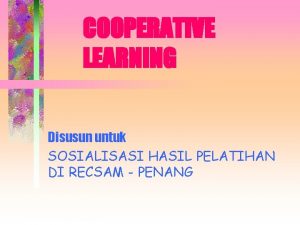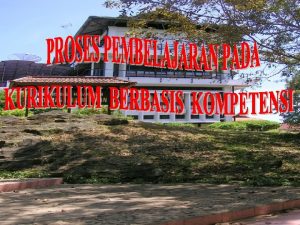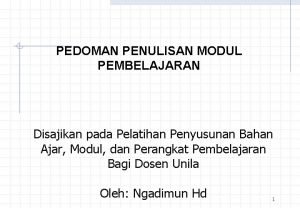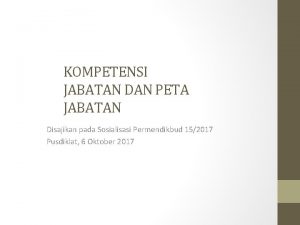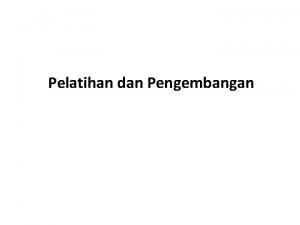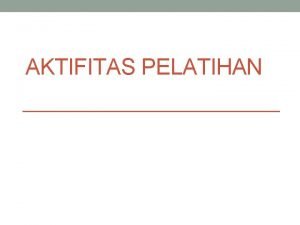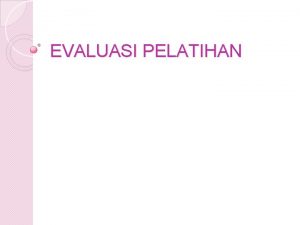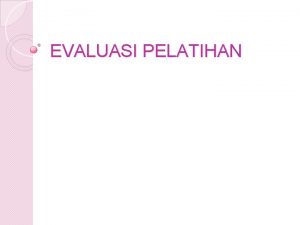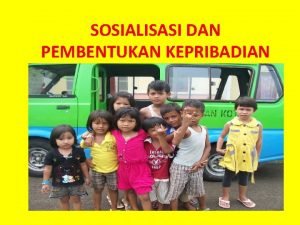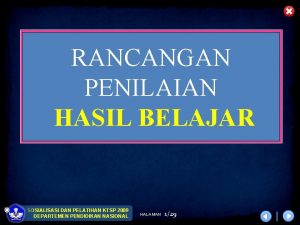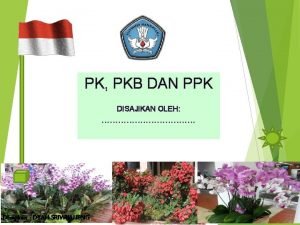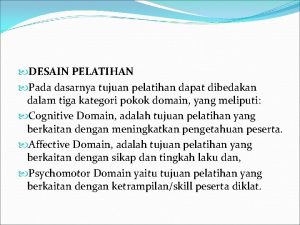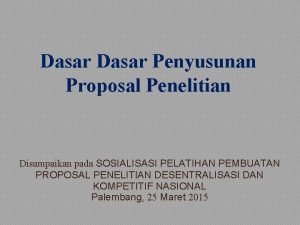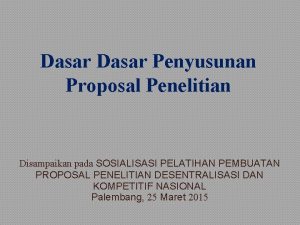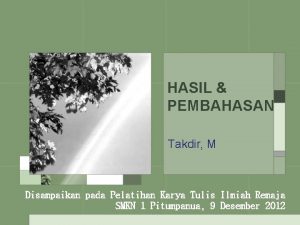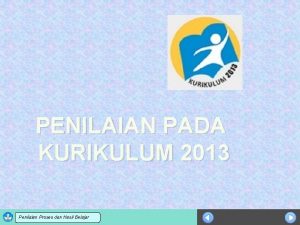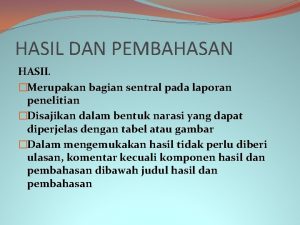CONTEXTUAL LEARNING Disajikan pada Sosialisasi Hasil Peserta Pelatihan



































- Slides: 35

CONTEXTUAL LEARNING Disajikan pada : Sosialisasi Hasil Peserta Pelatihan di Recsam Penang

The STRATEGIES of CL (based on Center for Occupational Research & Development) n Relating Learning in the context of one’s life experiences n Experiencing Learning by doing – through exploration, discovery, and invention n Applying Learning by putting concepts to use in hands-on, experiential and problem-solving activities n Cooperating Learning in the context of sharing, responding and communicating with other learners n Transferring Learning by using knowledge in a new context or situation

6 KEY ELEMENTS OF CTL (based on Northwest Regional Education Laboratory) n Meaningful Learning The understanding, personal relevance and valuing that a learner attaches to the content what is to be learned n Application of Knowledge The ability to see how what is learned applies to other settings and functions in the present or future n Higher Order Thinking The learner is required to use critical and creative thinking in collecting data, understanding an issue, or solving a problem n Standards-related Curricula The content of the instruction relates to a range and variety of local, state, nation, association and/or industry standards n Cultural Responsiveness Educators must understand respect the values, beliefs, and customs of our students n Authentic Assessment The use of multiple assessment strategies that validity reflect the actual outcomes expected of the learner.

TEACHING and LEARNING Characteristics Traditional Model PURPOSE Contextual Model Transmission of Finding, developing factual and applying information knowledge to real world ORGANIZATION Classroom isolated from connected and the world of patterned to the work while community and teachers and workplace students work alone

Continue …. Traditional Model ROLE of Transmitter of TEACHER knowledge ROLE of STUDENT Contextual Model Facilitator, coordinator or a knowledgeable guide to finding, developing and applying knowledge Passive recipient of Active engagement in facts and own learning; student information through constructs learning lectures and text through actual reading workplace activities

Continue …. Traditional Model Contextual Model CONTENT Subjects tailored for Subject application verbal and tailored for seven mathematical/logical multiple intelligences METHOD Lecture; question Inquiry; discovery, and answer; little contextual learning, and attention to variance applied methods in learning styles EVALUATION Testing of facts (e. g. , paper and pencil tests) Assessment of learning based on performance and problem solving (e. g. , portfolio assessment)

WHAT DOES A CLASSROOM LOOK LIKE? Conventional Classroom Contextual Learning Classroom Knowledge and the presentation of knowledge are the only important parts of the teachinglearning process. Thinking is usually done in theoretical and academic terms Helping students understand of knowledge is as important as dispensing knowledge. Thinking involves making the connecting between knowing and doing with “real-life” problem-solving issues.

Continue …. Conventional Classroom Students routinely work and study alone Lessons usually begin with theory or learning exercises that emphasize memorizing. Contextual Learning Classroom Students routinely work with teachers and peers in cooperative learning. Lessons usually begin with examples or problems from real-world experiences and then move out to interactively combine content with context

Continue …. Conventional Classroom Contextual Learning Classroom Academic and vocational education are approached education concepts are as though in isolation integrated wherever possible. Teachers tend to plan Teacher colleagues plan lessons and teach in lessons together and team isolation from colleagues. teaching wherever possible Time is the constant and Student mastery is the competence is the variable. constant and time is the variable.

SUGGESTED PEDAGOGICAL FLOW OF CONCEPT DEVELOPMENT IN CONTEXTUAL LEARNING Concept Development Observation and Discussion Concept Application. Related Activity Concept Introduction Experiment Problems / Questions

Project Based Learning PBL

WHAT IS PROJECT BASED LEARNING? PBL focuses on the central concepts and principles of a discipline, involves students in problem solving investigation and other meaningful tasks, allows students to work autonomously to construct their own knowledge, and culminates in realistic products.

Characteristic of PBL Content: n Problems presented in their full complexity n Students struggling with ambiguity, complexity, and unpredictability n Real-world questions that students care about

Activities: Investigative and engaging n n n Students conducting multi-faceted investigations extending over long periods of time Students encountering obstacles, seeking resources, and solving problems in response to an overall challenge Students making their own connections among ideas and acquiring new skills as they work on different tasks Students using authentic tools (i. e. real-life resources and technologies) Students getting feedback about the worth of their ideas from expert sources and realistic tests

Condition: Support student autonomy n n Students taking part in a community of inquiry and pursuing social context Students being called upon to exhibit task and time management behaviors both individually and as part of the group Students directing their own work and taking control over their own learning Students simulating the professional work of the scholar, researcher, engineer, reporter, planner, manager, and other practitioners

Results: real-world outcomes n n Students generating complex intellectual products that demonstrate their learning (e. g. , models, reports) Students participating in their own assessment Students held accountable for choosing how they will demonstrate their competence Students exhibiting growth in their frequently neglected areas important for real-world competence: social skills, life skills, selfmanagement skills, and dispositions to learn on one’s own

4 REASONS to TRAY PBL n n n 1. Content : focus on compelling ideas Can be: - presented realistically presented holistically, rather than in fragments investigated in depth allows learners to: form their own representations of complex topics and issues pursue aspects of content that match their own interests and abilities work on current topics that are relevant and of local interest draw content from their daily experience

2. Activities: An effective, engaging strategy Can be: challenging Provide students opportunities to: n learn complex ideas and skills in realistic settings n apply skills to a variety of contexts n combine skills, by completing “expert” tasks, professional duties, job performance, or real-life demonstrations n solve problems

Activities are constructive n Student experience able to construct their own knowledge n Can improve the “richness” (meaningfulness, connectedness) n Evokes active, deep, generative processing that keeps students interested and stimulates their initiative

Activities adapt to individual differences: n offers multiple ways for students to participate and to demonstrate their knowledge n accommodates different kinds of intelligence (e. g. , kinesthetic, figural) n can be matches to the learning style of students n shifts students away from doing only what they typically do n give parents meaningful information about varieties of student performance

3. Conditions: An empowering context n Conditions encourage social, personal, and collaborative skills. n Condition give students, more “authentic” learning experience; occurs a social context where interdependence and cooperation are crucial.

PBL n n n n offers a learning experience develop a variety of social skills promotes the internalization of concept, values, and modes of thought, (related cooperation and conflict resolution) establishes a supportive and non-competitive climate for students provides a means for transferring allows students to try out new skills and model complex behavior students explain or defend their position in their groups involve students who don’t usually participate

Conditions encourage mastery of technological tools. n n n expand students’ capabilities to display and manipulate information widen students’ interest and career options multiplies ways that individual students can contribute to project work

n n n RESULTS : Productive outcome PBL can be: Introduce the professional skills and strategies of a discipline impart the skills and strategies associated with planning, carrying out, monitoring, and evaluating a variety of intellectual investigations create a climate – students can learn and practice “learning to learn” skills (e. g. , skimming and note-taking, questioning, listening)

n n n continue. . . develop initiative, persistence, autonomy develop metacognitive skills (e. g. , selfmonitoring, self-evaluation) make learning meaningful by integrating concepts across subject-matter link cognitive, social, emotional, and selfmanagement

n n n n PBL helps develop: Group process skills Life skills (conducting a meeting, making a plan, using a budget, etc. ) Technological skills (using software, measuring, etc. ) Cognitive process skills (decision making, critical thinking, problem solving, etc. ) Self-management skills (setting goals, organizing tasks, managing time) Attitudes: love learning, interest in further education Dispositions: self direction, sense of achievement

Constructivis m

TRADITIONAL AND CONSTRUCTIVISM CLASSROOM TRADITIONAL CLASSROOM CONSTRUCTIVST CLASSROOM - Curriculum begins with the part of the whole. Emphasizes basic skills - Curriculum emphasizes big concepts, beginning with the whole and expanding to include the parts - Strict adherence to fixed curriculum is highly valued - Pursuit of student questions and interests is valued - Materials are primarily textbooks and workbooks - Materials include primary sources of material and manipulative materials - Learning is based on repetition - Learning is interactive, building on what the student already knows

- Teachers disseminate information to student, students are recipients of knowledge - Teachers have a dialogue with student helping student construct their own knowledge - Teachers role is directive, rooted in authority - Teachers role is interactive, rooted in negotiation - Assessment is though testing, correct answers. - Assessment includes student works, observations, and points of view, as well as test. Process is as important as product - Knowledge is seen as inert - Knowledge is seen as dynamic, ever changing with our experiences - Student work primarily alone - Student work primarily in groups

APPROACHES for IMPLEMENTING CL Problem-based Learning – engages learners in problem solving investigations that integrate skills and concepts from many content areas (Moffitt 2001) Cooperative Learning – organizes instruction using small learning groups in which students work together to achieve learning goals (Holubec 2001) Project-based Learning – focuses on the central concepts and principles of a discipline, involves students in problem solving investigations and other task (Buck Institute for Education 2001) Service Learning – provides a practical application of newly acquired knowledge and skills to needs in the community through project and activities (Mc-Pherson 2001) Work-based Learning – workplace, or workplace-like, activities are integrated with classroom content (Smith 2001)

PRINCIPLES OF IMPLEMENTING CONSTRUCTIVISM IN THE CLASSROOM • • • Pose problems relevant to the students Structure learning around essential concepts Seek and value student suppositions Adapt curriculum to address students suppositions and development Assess student learning in the context of teaching

Three Constructivist Design Model 1. The Learning Cycle q q q The teacher encourages students to generate questions and hypotheses from working with materials. The teacher focuses on the students’ question and helps them create hypotheses and design experiment concept application

• • • 2. Constructivist Learning design by George Gagnon Jr. , and Michelle Collay develop a situation for students to explain select process for grouping of materials and students build a bridge between what students already know and what the teachers want them learn anticipate questions to ask and answer without giving away an explanation encourage students to exhibit a record of their thinking by sharing it with others solicit students reflections about their learning

The Information Construction (ICON) Model 1. Observation 2. Interpretation construction 3. Contextualization 4. Cognitive Apprenticeship 5. Collaboration 6. Multiple Interpretations 7. Multiple Manifestations

 Gambar cerita iklan
Gambar cerita iklan Broth bouilion
Broth bouilion Contoh bukti diseminasi kebijakan halal
Contoh bukti diseminasi kebijakan halal Perbedaan internalisasi sosialisasi dan enkulturasi
Perbedaan internalisasi sosialisasi dan enkulturasi Hakekat sosialisasi adalah …
Hakekat sosialisasi adalah … Pentingnya sosialisasi budaya politik
Pentingnya sosialisasi budaya politik Sosialisasi buku kia 2020 ppt
Sosialisasi buku kia 2020 ppt Konsep sosialisasi
Konsep sosialisasi Pengertian sosialisasi kurikulum
Pengertian sosialisasi kurikulum Rancangan pembelajaran bersosialisasi
Rancangan pembelajaran bersosialisasi Fungsi sosialisasi keluarga
Fungsi sosialisasi keluarga Peran perawat sebagai konsultan
Peran perawat sebagai konsultan Indikator sosialisasi
Indikator sosialisasi Fungsi sosialisasi keluarga
Fungsi sosialisasi keluarga Konsep sosialisasi
Konsep sosialisasi Contextual teaching and learning
Contextual teaching and learning Cuadro comparativo e-learning y b-learning
Cuadro comparativo e-learning y b-learning Artikel ilmiah disajikan berdasarkan …
Artikel ilmiah disajikan berdasarkan … Instrumen proses pembelajaran
Instrumen proses pembelajaran Struktur penyajian berita tersaji dalam pola apa
Struktur penyajian berita tersaji dalam pola apa Teknik penyajian algoritma
Teknik penyajian algoritma Pengertian algoritma dan flowchart
Pengertian algoritma dan flowchart Contoh sasaran pelatihan
Contoh sasaran pelatihan Pelatihan dan pengembangan sdm ppt
Pelatihan dan pengembangan sdm ppt Model pelatihan
Model pelatihan Adhyatman adalah
Adhyatman adalah Pertanyaan tentang need analysis
Pertanyaan tentang need analysis Rencana aksi perubahan pkp
Rencana aksi perubahan pkp Desain pelatihan psikologi
Desain pelatihan psikologi Contoh audit pelatihan dan pengembangan sdm
Contoh audit pelatihan dan pengembangan sdm Cara menghitung desain pelatihan
Cara menghitung desain pelatihan Contoh laporan kegiatan pelatihan pertanian
Contoh laporan kegiatan pelatihan pertanian Faktor penyebab perlunya pelatihan
Faktor penyebab perlunya pelatihan Pelatihan tenaga penjualan
Pelatihan tenaga penjualan Desain evaluasi pelatihan
Desain evaluasi pelatihan Contoh asb
Contoh asb
